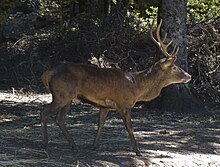Corsican red deer
| Corsican red deer | |
|---|---|

| |
| A male Corsican red deer | |
| Scientific classification | |
| Domain: | Eukaryota |
| Kingdom: | Animalia |
| Phylum: | Chordata |
| Class: | Mammalia |
| Order: | Artiodactyla |
| Family: | Cervidae |
| Subfamily: | Cervinae |
| Genus: | Cervus |
| Species: | |
| Subspecies: | C. e. corsicanus
|
| Trinomial name | |
| Cervus elaphus corsicanus Erxleben, 1777
| |
The Corsican red deer (Cervus elaphus corsicanus), also known simply as the Corsican deer or Sardinian deer, is a subspecies of red deer (Cervus elaphus) found on the Mediterranean islands of Sardinia (Italy) and Corsica (France).
Characteristics

The Corsican red deer is smaller than most of the 16 subspecies of the red deer; it has shorter legs (possibly to better scramble up mountain sides) and a longer tail.[2] The antlers are also simplified and shorter, typically less than 80 cm (31 in) in length. The coat is brownish. Life expectancy is 13–14 years. Males reach a height of 86 to 110 cm (34 to 43 in) and a weight of 100 to 110 kg (220 to 240 lb); while females measure 80 to 90 cm (31 to 35 in) and weight 80 kg (180 lb).[3]
Reproduction
This subspecies reach sexual maturity at 2 years of age. Mating lasts from August to November and can involve mortal battles. The dominant male finally secures most of the mature females, typically 12 per male. After gestation, in May–July, females hide alone in the maquis (the dense vegetation) to deliver, typically a single birth per female. Males leave the matriarchal group following the reproductive period.[3]
Distribution and habitat
The Corsican red deer was introduced to the
Conservation status
The subspecies gets its name from the island of Corsica from where it was, however,
See also
Notes
- ^ "Species Profile". Archived from the original on 2021-04-28. Retrieved 2020-02-06.
- ^ a b Hughes West 2008, p 146
- ^ a b Natura 2000, in French
- S2CID 26357327.
- ^ Kidjo et al. 2007
References
- Hughes, Holly; West, Larry (2008). "Regional Nature Park of Corsica: Welcome Home, Deer". Frommer's 500 Places to See Before They Disappear. Frommer's. ISBN 978-0-470-18986-3.
- Kidjo, Nicolas; Feracci, Gérard; Bideau, Eric; Gonzalez, Georges; Mattéi, César; Marchand, Bernard; Aulagnier, Stéphane (2007). "Extirpation and reintroduction of the Corsican red deer Cervus elaphus corsicanus in Corsica". Oryx. 41 (4). Cambridge University Press: 488–494. .


